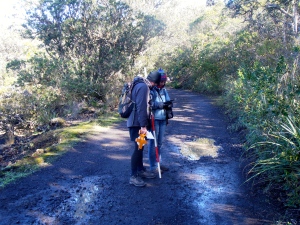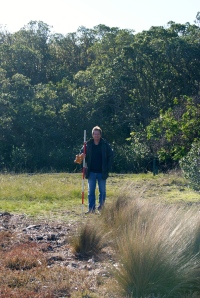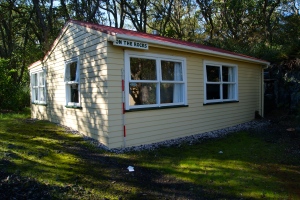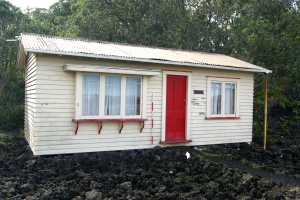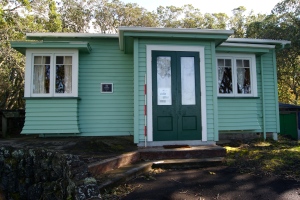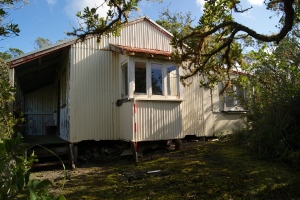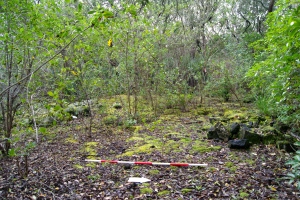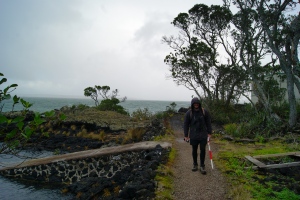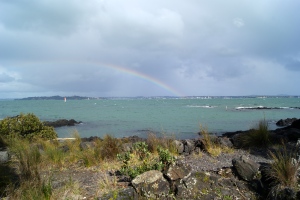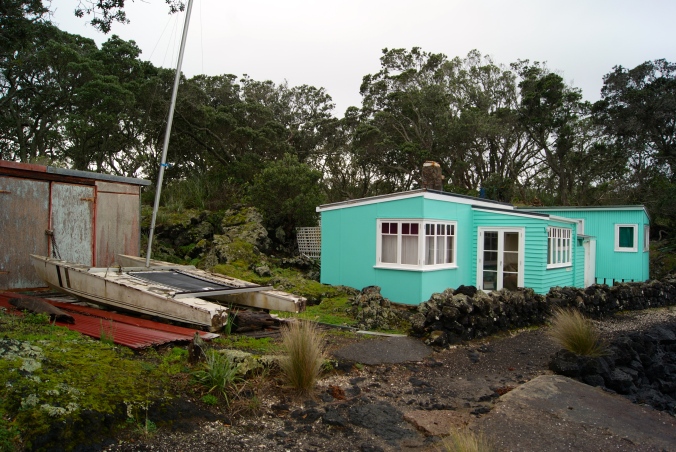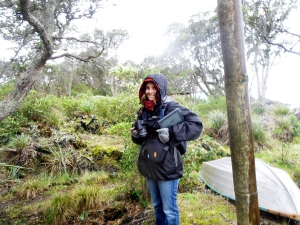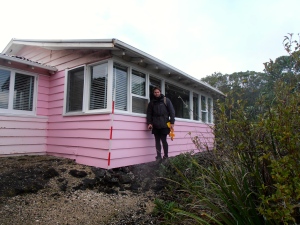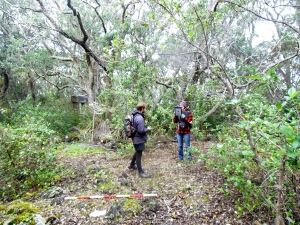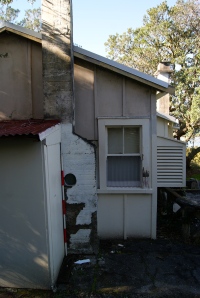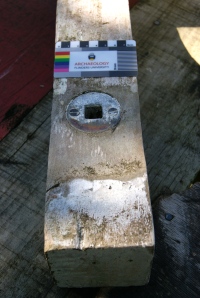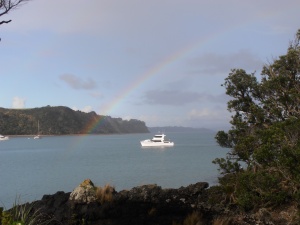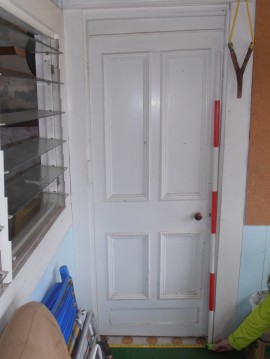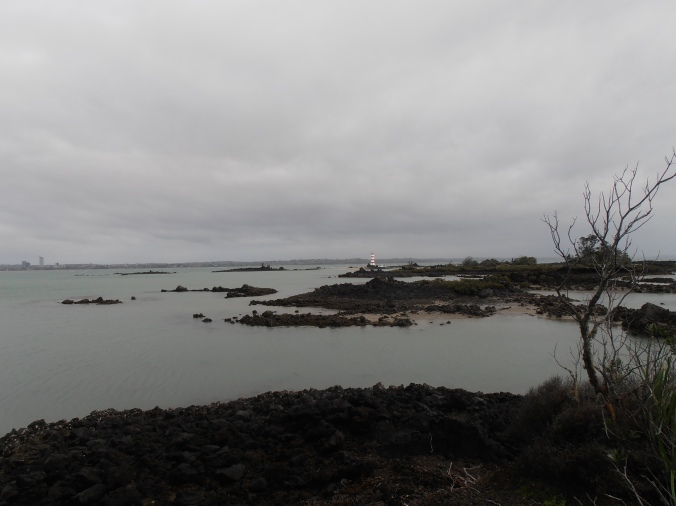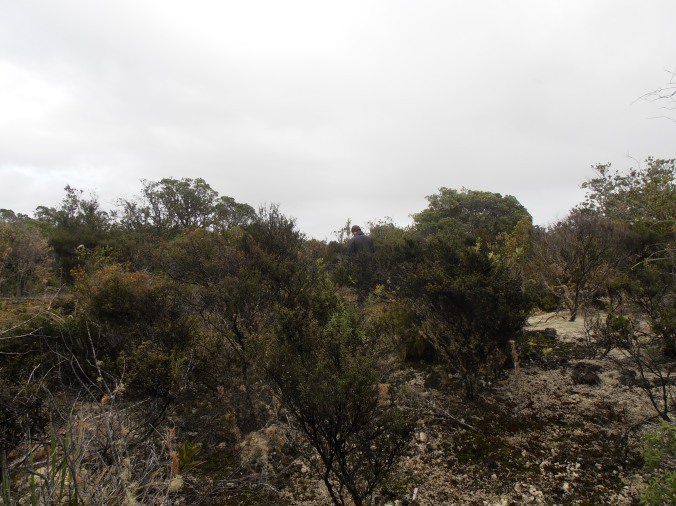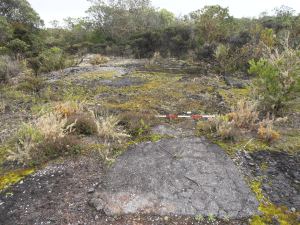With fieldwork now finished this is the last piece of the pie. We hope that you have enjoyed the blog and thank you for all of the support. The video documents our time on the island and the work that was carried out—enjoy! /KB
Archaeology—baches
The penultimate day…
Today was most likely our second to last day on Rangitoto. We returned to Rangitoto Wharf where we recorded another 11 extant and demolished baches.
We also fixed a GPS position on several of the public buildings at the wharf, like the store, honey house, changing rooms, telephone and swimming pool. We were lucky in meeting a couple of bach owners who are staying in their bach at the moment, who were very welcoming and allowed us to view the interior of the bach.
Vessel material located was two possible ships tanks. After getting a lift both ways today, from Islington Bay and Rangitoto Wharf, we are now in a good position to complete the archaeological surveys tomorrow. /MF
On the coast, up the hill, some are here, some are gone
Today, we returned back to Rangitoto Wharf and continued on from yesterday. The surveyed bach sites ranged from existing dwellings to demolished sites and were located along the coastal track and tucked amongst the trees inland. Once neatly manicured tracks are now heavily disguised with overgrown vegetation. After bashing your way through the bush, a clearing where a building once stood proud, can be seen.
When looking for a demolished bach site, you need to look for a large clearing amongst the trees, usually flat and a stone lined pathway leading to the site. Once at the site you can expect to find cultural remains, such as, water tanks, outhouses (long drops), concrete foundations, corrugated iron, fibrolite (asbestos-cement sheeting), ceramics, window glass and a bottle dump. We may think the baches no longer remain but cultural features still remind us of a holiday retreat. As for archaeology, so much could be learned about the behaviour of bach residents, but this will have to be sidelined for a future project! /KB
Rangitoto Wharf
Today was the first day of recording baches at the Rangitoto Wharf bach community.
This group of baches is located on the southern side of the island and is the largest of the three, slightly larger than Islington Bay.
This is usually the central hub for ferries and tourists however the wharf is being rebuilt which is why we are taking the ferry to Islington Bay for fieldwork. Starting at the western end of the community, we worked our way back to the east, towards Islington Bay, and recorded 13 baches.
We were also lucky to get a lift back to the ferry, saving an hour-long walk. Tomorrow, we will be returning to where we left off today. /MF
Frost foreshadows fruitful finds
Early frost on Islington Bay wharf yesterday boded well for a successful and final day at the Islington Bay baches.
Being dropped off by Chinook allowed a full 2 hours extra working time before the first ferry arrived. One of the days highlights was locating possible porthole glass being used as a window in the back of a chimney at one bach.
The other high point was finding two masts which were used in the construction of a treehouse in the garden of a bach.
While these masts are unlikely to be from the ships graveyard because they would be from smaller vessels, it is still an exciting sign of salvage and reuse of vessel material!
We are now taking a well-earned rest day after 8 continuous days of fieldwork on Rangitoto, but will be back tomorrow for our first day at the Rangitoto Wharf bach community. /MF
Thirsty anyone?
Today, ships water tanks made up the main finds at the Islington Bay bach sites. In total five were photographed and measured. They ranged in size from 100cm (39.4 inches) x 100cm x 100 cm to 122cm (48 inches) x 122cm x 122cm. These sizes seem to fit the measurements of the Braby designed ships water tank, as well as displaying the rounded riveted seams on all edges (Pearson 1992: 24). All were painted in a bright silver colour and at one time connected to the baches as a source of water.
All bach sites south of Islington Bay wharf have been completed. Tomorrow, work will start towards the north and continue around to Gardiner Gap. /KB
Pearson, Michael
1992 From Ship to the Bush: Ship Tanks in Australia. Australian Historical Archaeology 10: 24–29.
Sound the foghorn—We’re done at Beacon End!
When the team went to launch Chinook off the Takapuna boat ramp at 07:00 this morning, the thick fog that had settled in over the greater Auckland region had still not cleared.
The fog would prove to be problematic for the remainder of the morning, but with Howard Bennett as our captain we were able to safely make the trip over to Rangitoto Island. A total of eight bach sites were looked at in the vicinity of Beacon End (McKenzie Bay), with one of those sites possessing a timber that could potentially be from a ship.
The fog cleared in the late afternoon—making it possible to stay on the island a bit later and trek over to White’s Beach to get our data for the eighth and final bach in the bay.
The team was all aboard Chinook again by 17:00. What started off as a potentially unproductive day turned into quite a successful one! /VS
Ships doors and ships tanks
Today began with a gorgeous sunny morning, however ended with some heavy showers during the afternoon dash to catch the last ferry home.
The team of three covered a lot of ground in the southern area of Islington Bay, recording several baches.
Two finds today may indicate some maritime salvaging activities.
The first is a potential ships door, identified as such due to its narrow width and angled frame. This was found amongst a pile of timbers from a demolished bach.
The second is the remains of a ships tank found at a site that was most likely a bach, although was not recorded on a map of the baches which dates to the 1930s. /MF
Looking at a bach from the inside out
The weather from my window this morning had me questioning if it was going to be another day off the island, but fieldwork was a go despite the periodically heavy rains. It was only my first day out on Rangitoto; however, it was another successful day of fieldwork for the project. The team got to see the inside of a bach, identified some possible ship doors and fixtures, and documented a total of six bach sites!
Work started on the island when we arrived off the ferry at 0945. To spare Kurt from another day of cross-island trekking, the team stayed in the Islington Bay area. It was there that a bach owner gave us a peek into the interior of his island getaway. Looking out over the water from the front door it is easy to imagine kicking your feet up on a warm summer day and escaping from the daily hustle and bustle of city life. As much as we would have loved to do just that, there was much work to be done.
Two of the baches investigated today displayed evidence of vessel materials. The possible ship doors and fixtures that were identified require some additional investigation, but key features keep us hopeful! The team was keen to keep on recording however the 1600 ferry drew our day to a close. Looks like we will just have to wait until tomorrow! /VS
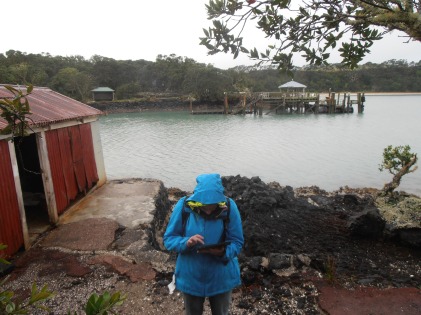
Vanessa Sullivan at Islington Bay
Land ahoy!
Yes, I am pleased to announce that today was the day! I sighted land and manged to step foot on to the island without weather troubles. I caught up with one of the Islands’ rangers, John Duggan, who kindly gave me a ride to Beacon End (McKenzie Bay). I allowed 2 hours to walk one way from the Islington Bay wharf so a ride was a big help.
The ferry departed at 0915 and arrived at Islington Bay around 1025. Once I was dropped off at Beacon End I proceeded to start from the south and work my way back up north. The first bach site played hide and seek and was not found until 1115. It was the site of S. Luxford according to the map below.
There was no bach left but its footprint in the scrub can still be seen. Amazingly there were still remnants of beehives and evidence that the island at one time contributed to the honey industry—Pohutukawa honey! The second and last site for the day was the Eagles family bach. The bach was amazing and in such an idyllic spot. You could tell it was a happy place full of lasting memories. This was the last site to be visited due to allowing the 2 hours for the trek back to catch the ferry. No ship material was seen today, but not to worry as I have over 100 sites still to visit. Also, to back up my point of Rangitoto being deceivingly large, I managed to clock up 13.5km walking today. Not bad for 5 hours of work! /KB
